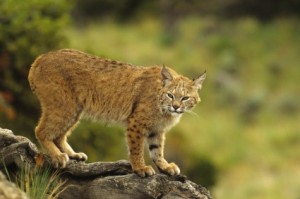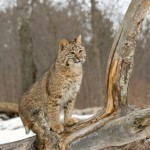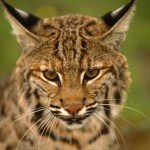Bobcat – Lynx rufus
Family, Description and Size:
The Bobcat (Lynx rufus) is a North American mammal of the cat family Felidae or felines; specifically it is one of the four lynx species. It is the smallest of the lynx genus, having twice the size of the average domestic cat. Like all lynx genus it has a short puffy tail, long ears with black tufts and long, downward-facing hair beneath their ears. They have long whiskers, a usually reddish nose and round pupils. Bobcats have yellow eyes and a coat that ranges from red to reddish-brown. Their coat has grey dots all over its back and black stripes on its forelegs, a signature characteristic of the species.
The average weight is 8.8 to 34 pounds, twice that of a domestic cat, and their average length from snout to tail is 18.5 to 49 inches. They have retractable claws and sharp long teeth, which both are its main hunting and defensive weapons.
Range and habits:
The bobcat is carnivorous and usually feeds on any creature that is smaller than itself. Its preferred prey is hares and rabbits, but when those don’t exist in abundance then small rodents and birds will do. The diet of the bobcat is mainly dependent on the population of its main prey (rabbits, hares and birds); when those can’t be found then their diet varies wildly and may include fruit or nuts.
Bobcats are no danger to large farm animals like cows and horses, but have been known to be a danger to goats and sheep. They are daring animals and will hunt down a sheep or goat even though it may be at least twice their size. During winter the bobcat may even hunt deer. When its prey is large it will eat its fill and bury the carcass beneath leaves or snow, returning at a later date to feed again on the carcass. This allows the bobcat to feed on a kill longer, which is necessary particularly in winter when prey can sometimes be scarce.
Bobcats have many ways of hunting. They pounce on small rodents, stalk and chase rabbits and hares, and they attack deer when they are lying down, biting their neck or back of the skull. Bobcats are very fast and have an acute sense of hearing. They are excellent climbers as well.
General Information:
Bobcats can be found all over North America, from northern Mexico to southern Canada. However, the bobcat does prefer to live in places where the snow is not deep during winter, because it lacks its Canadian cousin’s large padded feet and thus can’t stand on snow very well. Almost all habitats can be colonized by bobcats, except for long ranges of commercially cultivated lands with no brushy borders. Bobcats have been detected in the suburbs of New York, deciduous and coniferous forests and also deserts and prairies.
The bobcats have an estrus cycle of 44 days, which is continuously cycling from early spring to summer. They usually have their first litter during April and may and might have a second one in September. A female may mate with multiple males and a male might mate with multiple females. A chief condition for successful breeding is that both animals have a set range of territory. Kittens are born blind and with spotted fur. They open their eyes 10 to 14 days after birth. Each litter usually has two to four kittens in it.
Like most felines, bobcats are solitary and territorial. Territories may overlap to a small extent among males, which is rather unique for a cat species, but females usually have strictly separate territories. Whenever more than one male is active in a territory, rules of dominance are set in place, with the less dominant bobcat being excluded from some preferred territory of the dominant cat. The way they mark their territory is usually with piles of feces, sprays of urine and scratches on trees, which are all obvious signs for other bobcats to stay clear or to approach for a fight.
Predators, mortality and lifespan:
The main predators of bobcats -humans aside- are wolves, coyotes and cougars. Bobcat numbers are also culled from disease, starvation and car accidents. Young kittens are being preyed upon by owls, eagles, foxes and sometimes even adult male bobcats. High mortality is seen among juveniles who have just left their mother as they have yet to master their hunting skills.
Bobcats live on average between six to eight years of life. In captivity the longest lifespan recorded was thirty two years. Even though they face many dangers, from humans, parasites and starvation bobcats enjoy a healthy and stable population and are not endangered. Hunting is permitted, with some states requiring a tag or license.
- New Labradar LX Compact Doppler Radar Chronograph - January 28, 2024
- New Winchester XPert 17WSM Rimfire Rifle for 2024 - January 17, 2024
- Ruger Firearms Announces New Super Redhawk Revolver in .22 Hornet - December 11, 2023





